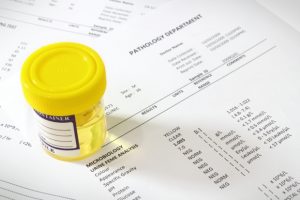 Leukocytes are white blood cells that work with the immune system to fight off infections. Leukocytes can appear in the urine if there is damage to the kidneys, ureters, urethra, or bladder. They can also be triggered if there is a foreign substance in the body. There are five different types of leukocytes, and if one particular type is found in excess in urine it could signify disease.
Leukocytes are white blood cells that work with the immune system to fight off infections. Leukocytes can appear in the urine if there is damage to the kidneys, ureters, urethra, or bladder. They can also be triggered if there is a foreign substance in the body. There are five different types of leukocytes, and if one particular type is found in excess in urine it could signify disease.
Leukocytes are released through urine when they are damaged or killed as a result of fighting off infection. There is normally a small level of leukocytes found in urine as the old cells are passed through the body. But if the leukocyte count in urine is high, it could be a sign of something more serious.
Advertisement
Leukocytes can appear in the urine for several reasons including pregnancy, kidney infections, holding in your urine for too long, or a blockage in the urinary tract system.
Diagnosis and tests for leukocytes in urine
A normal range of leukocytes in the blood is between 4,500 and 11,000 white blood cells (WBCs) per microliter. In the urine, it is much lower, between zero and five WBCs per high power field.
The best way to determine the range of leukocytes in the urine is through urinalysis. A level above five wbc/hpf indicates an infection, further prompting your doctor to check for the bacteria that have caused the infection in order to prescribe an effective antibiotic to treat the infection.
How to get rid of leukocytes in urine without antibiotics
If your elevated leukocyte levels in urine is caused by bacteria, here are some naturally ways to lower your levels without the use of antibiotics.
Drink lots of water: What isn’t drinking water good for, really? It helps flush away the bacteria, putting you on track for recovery. Eight glasses a day is a general guideline. Add fresh lemon or lime to boost flavor and help with detoxification.
Ease the pain with heat: Inflammation and irritation from UTIs can leave you with pressure and pain around your pubic area or lower back. Try some heat therapy. Apply a heating pad at low temperature for about 10 to 15 minutes at a time.
Get more vitamin C: This healthy vitamin found in berries (like cranberries!), citrus fruits, melons, and cabbage can help make your urine more acidic, which helps support a healthy urinary tract.
Eat some yogurt: You want to blast those bad bacteria with good bacteria. If you’ve read anything about yogurt these days, you’ll know the popular dairy treat is packed with probiotics, or good bacteria, for your gut.
Ditch the irritants: Now’s the time to focus on your health, so you want to cut out things that can irritate your bladder and make it harder for your body to heal. The culprits? Caffeine, nicotine, spicy food, alcohol, carbonated drinks, and those bad-for-you artificial sweeteners. On the upside, consume more high-fiber carbohydrates like grains, and healthy fats like nuts and olive oil – all good for digestion.
Run to the bathroom: While it’s unpleasant and annoying, keep making those bathroom trips. Every time you go, even if you urinate only a small amount, you’re getting rid of some of the bad bacteria that’s causing the UTI.
Wipe front to back: Another bathroom tip, always wipe from the front to back to avoid infection. Don’t try to reach from behind – germs from the rectum can be transferred to the toilet paper or your hand. Also, never wipe twice with the same tissue.
Drink parsley water: It is a natural diuretic and can help flush out your system.
Advertisement
Consume more blueberries: They contain ingredients that can work to prevent and treat UTIs.
Consume diluted apple cider vinegar: It is a natural antibacterial, so it can help fight off bacteria in the urinary system.
These tips will not only help you treat any infection, but if practiced regularly can help reduce the risk of infection, too.
